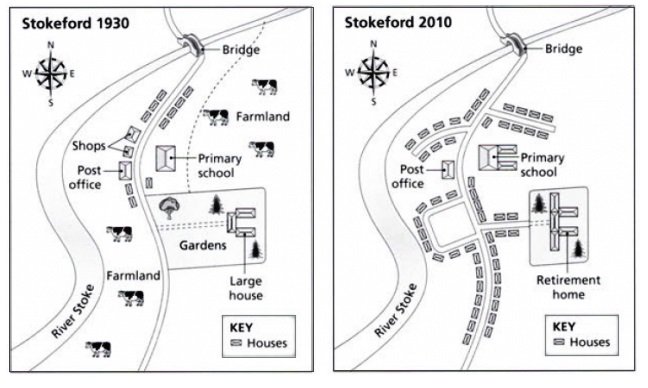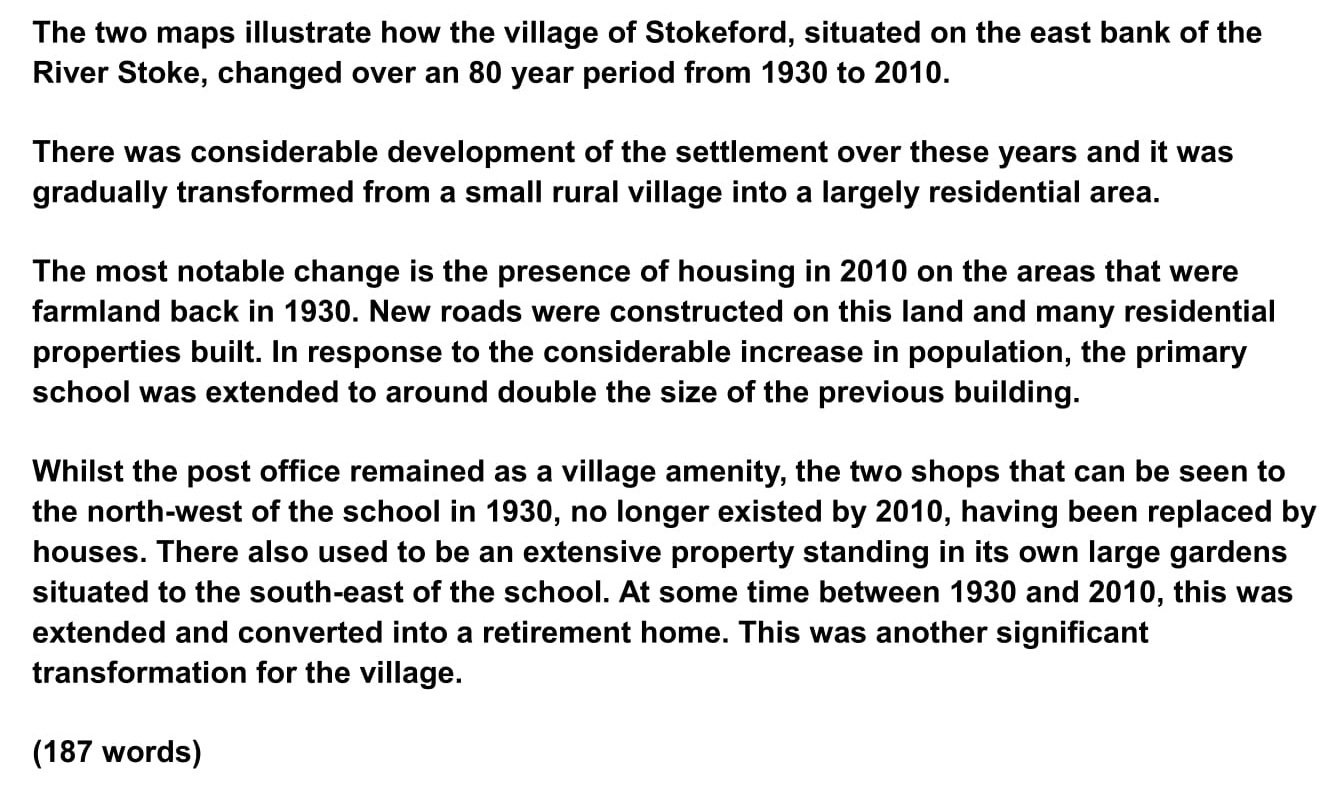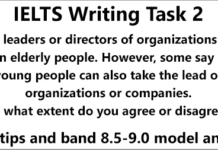How To Write an
IELTS Map Essay
IELTS map questions are the easiest to answer. There are no numbers to analyse, just 2 or 3 maps to compare. Very occasionally, there might only be a single map, but this is rare.
The maps will be of the same location at different times. This could be in the past, the present time or a plan for a proposed development in the future. You are required to write about the changes you see between the maps.
There are 5 steps to writing a high-scoring IELTS map essay:
1) Analyse the question
2) Identify the main features
3) Write an introduction
4) Write an overview
5) Write the details paragraphs
I must emphasise the importance of steps 1 and 2. It is essential that you complete this planning stage properly before you start writing. You’ll understand why when I guide you through it. It should only take 5 minutes, leaving you a full 15 minute to write your essay.
In this lesson, we’re going to work through the 5 stages step-by-step as we answer a practice IELTS map question.
Before we begin, here’s a model essay structure that you can use as a guideline for all IELTS Academic Task 1 questions.
Ideally, your essay should have 4 paragraphs:
Paragraph 1 – Introduction
Paragraph 2 – Overview
Paragraph 3 – 1st main feature
Paragraph 4 – 2nd main feature

We now have everything we need to begin planning and writing our IELTS map essay.
Here’s our practice question:
The maps below show the village of Stokeford in 1930 and 2010.
Summarise the information by selecting and reporting the main features, and make comparisons where relevant.
Write at least 150 words.

Step 1 – Analyse the question
The format of every Academic Task 1 question is the same. Here is our practice question again with the words that will be included in all questions highlighted.
The maps below show the village of Stokeford in 1930 and 2010.
Summarise the information by selecting and reporting the main features, and make comparisons where relevant.
Every question consists of:
- Sentence 1 – A brief description of the graphic
- Sentence 2 – The instructions
- The graphic – map, chart, graph, table, etc.
Sentence 2 tells you what you have to do.
You must do 3 things:
1. Select the main features.
2. Write about the main features.
3. Compare the main features.
All three tasks refer to the ‘main features’ of the graphic. You do not have to write about everything. Just pick out 2 or 3 key features and you’ll have plenty to write about.
Step 2 – Identify the Main Features
All you are looking for are the main features. Start with the earliest map. Identify the key features and look to see how they have changed in the later map, and again in the final map if there are three.
Here are some useful questions to ask?
1) What time periods are shown?
Are the maps of past, present or future situations? This is important to note because it will determine whether you write your essay using past, present or future tenses.
The two maps in our practice IELTS map question show the village of Stokeford at two different times in the past. This immediately tells us that we will need to use the past tense in our essay.
2) What are the main differences between the maps?
What features have disappeared? What new features are in their place?
3) What features have remained the same over the time period?
Although the location on the maps will have undergone major development, some features may remain unchanged.
Also, think about directional language you can use, such as:
- north
- south
- east
- west
- north-east
- north-west
- south-east
- south-west
So, what information is contained our maps? Here they are again.

Source: IELTS past paper
There are a number of different features we could select such as, the loss of the shops, the disappearance of farmland, the enlargement of the school and the development of the large house into a retirement home.
Many maps will contain far more changes than our sample maps and the changes may be more complex. In such cases, you won’t have time to write about all of them and will need to select just 2 or 3 main features to focus on.
Our maps are quite simple so we’ll list all 4 of the major changes I’ve just identified.
Main feature 1: The farmland has been built on.
Main feature 2: The large house has been converted into a retirement home.
Main feature 3: The school has been enlarged.
Main feature 4: The shops have disappeared.
The key features you select will be the starting point for your IELTS map essay. You will then go on to add more detail later. However, with just 20 minutes allowed for Task 1, and a requirement of only 150 words, you won’t be able to include many details.
We’re now ready to begin writing our essay. Here’s a reminder of the 4 part structure we’re going to use.
Paragraph 1 – Introduction
Paragraph 2 – Overview
Paragraph 3 – 1st main feature
Paragraph 4 – 2nd main feature
For this essay, we’ll adapt this a little to write about two of the features in Paragraph 3 and the other two features in Paragraph 4.
Step 3 – Write an Introduction
In the introduction, you should simply paraphrase the question, that is, say the same thing in a different way. You can do this by using synonyms and changing the sentence structure. For example:
Question:
The maps below show the village of Stokeford in 1930 and 2010.
Introduction (Paragraph 1):
The two maps illustrate how the village of Stokeford, situated on the east bank of the River Stoke, changed over an 80 year period from 1930 to 2010.
This is all you need to do for the introduction.
Step 4 – Write an Overview (Paragraph 2)
In the second paragraph, you should describe the general changes that have taken place. The detail comes later in the essay.
State the information simply. No elaborate vocabulary or grammar structures are required, just the appropriate words and correct verb tenses.
For example:
Overview (Paragraph 2):
There was considerable development of the settlement over these years and it was gradually transformed from a small rural village into a largely residential area.
Two sentences would be better than one for the second paragraph but we’ll be getting into the detail if we say more about these maps at this point, so we’ll leave the overview as one sentence.
Step 5 – Write the 1st Detail Paragraph
Paragraphs 3 and 4 of your IELTS map essay are where you include more detailed information. In paragraph 3, you should give evidence to support your first 1or 2 key features.
In the case of our main features, 1 and 3 are closely related so we’ll write about these two together.
Here they are again:
Main feature 3: The school has been enlarged.
And this is an example of what you could write:
Paragraph 3:
The most notable change is the presence of housing in 2010 on the areas that were farmland back in 1930. New roads were constructed on this land and many residential properties built. In response to the considerable increase in population, the primary school was extended to around double the size of the previous building.
Step 6 – Write the 2nd Detail Paragraph
For the fourth and final paragraph, you do the same thing for your remaining key features.
Here are the two we have left:
Main feature 2: The large house has been converted into a retirement home.
Main feature 4: The shops have disappeared.
This is an example of what you could write:
Paragraph 4:
Whilst the post office remained as a village amenity, the two shops that can be seen to the north-west of the school in 1930, no longer existed by 2010, having been replaced by houses. There also used to be an extensive property standing in its own large gardens situated to the south-east of the school. At some time between 1930 and 2010, this was extended and converted into a retirement home. This was another significant transformation for the village.
Here are the four paragraphs brought together to create our finished essay.
Finished IELTS Map Essay

This sample IELTS map essay is well over the minimum word limit so you can see that you don’t have space to include very much detail at all. That’s why it is essential to select just a couple of main features to write about.
Now use what you’ve learnt in this lesson to practice answering other IELTS map questions. Start slowly at first and keep practicing until you can plan and write a complete essay in around 20 minutes.
IELTS Writing Task 1 Map Essay IELTS Writing Task 1 Map Essay IELTS Writing Task 1 Map Essay







